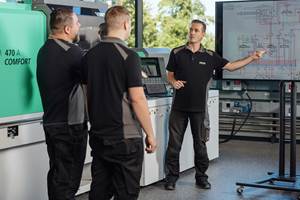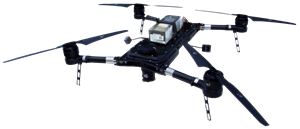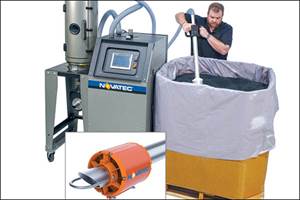EPS Bead Molders Turn To Automation
Plantwide automation in EPS molding started among European block molders, who created ‘ghost’ plants with only a handful of workers where dozens had been employed before. Now, ‘hands-off’ automation has reached the U.S. and is making inroads in shape molding, too.
Automation in EPS bead molding has gone well beyond robotic handling of mold inserts and parts removal. Today, automation has reached the plantwide level. EPS bead materials can travel all the way through molding and fabricating to a finished product, wrapped and ready for shipping—all without being touched by human hands.
Accomplishing this involves a combination of mechanical devices and robots that automatically fill molds, control molding cycles, remove blocks, slice them, trim edges, and then sand, wire-cut, rout, stack, palletize, wrap, and pack the boards or shapes on skids or in boxes. Some of these devices are “smart” enough to calculate the most efficient way to cut a block of foam and produce the least waste.
That level of automation began more than five years ago across the Atlantic. “In Europe, there are many such plants today called ‘ghost plants’ because so few people work in them,” says Sebastian Schmidt, president of Kurtz North America. Its parent company in Germany was the first EPS machine builder to program 3D robots for block molding.
The push for automation stalled somewhat during the worldwide recession of the past two years. “Nobody wanted to invest,” recalls Mark Clark, president of Hirsch USA. “But now they have to because raw-material costs are going up.”
What appears to be the first U.S. block-foam plant automated on the European model has been running since last year, though the company would not speak for publication. The plant, which underwent a total automation retrofit, shrank in staff from 180 employees to eight.
"Now, to be competitive, other molders will have to invest or lose margins," says Murray Patz, a consultant for Kurtz. In Europe, the high cost of labor is the main incentive to automate. In the U.S., the motive is the scarcity of reliable labor in low-skilled material-handling jobs.
After a couple of years of flat or shrinking markets, EPS molders now face rising material costs, and any competitive edge counts. “Getting a price increase is unheard of in this business, so we’re always looking at being more efficient,” says Gerry Babyok, manufacturing manager of Life-Like Products LLC in Baltimore, who is considering automation for his block- and shape-molding plant. “Life-Like is looking at every labor center and automating where it makes sense. There are a lot of little things, like automatic taping and stacking.”
Automating block molding
Kurtz has developed custom robotic handling systems launched earlier this year, called ProRob. The first total automation installations five years ago were mechanical and linear, with operations laid out like a street. This worked for plants with a dedicated product line and few changeovers—namely in block molding.
The latest ProRob configurations are flexible, self-contained work cells. One or two robots are centrally placed in the work area. They pivot and may slide back and forth on rails, as well. The work area can be reconfigured for different products or operations. All applications so far are in cutting block foam into sheets.
As an example, a work station with two pivoting stationary robots might take EPS sheets, trim their edges, and palletize them. Robot #1 takes a cut sheet and pivots to load it on an edge trimmer. After trimming, the robot moves the sheet to a packaging machine for wrapping. Robot #2 takes wrapped blocks of sheet and stacks them on a pallet for shipping.
Another ProRob configuration uses just one pivoting robot that travels back and forth on a short track between a board-sanding station and a packing station. The robot starts by picking up sheets from a cutting line and positioning them in the sanding machine. The robot then shuttles to the other end of the sanding machine to pick up the sanded boards, stack them, pick up a pallet, put the stack of sheets on the pallet, and move the loaded pallet to a wrapping machine.
ProRob workstations can also be configured to load and unload contour cutters or to nest and stack the cut parts. Robots can also feed EPS sheet to down-cutters for fabricating small parts and then pack the parts in boxes.
In other news, more makers of shape-molding machinery are coming out with block-molding systems. The latest is Teubert Maschinenbau in Germany, represented here by Foam Equipment & Consulting. Two years ago, Erlenbach of Germany, represented here by Profoam International, introduced its first horizontal and vertical block-molding machines, which have the steam chamber built into the adjustable wall in order to economize on steam usage.
Automated shapemolding
Block molding is where automation has had the most success so far, although machine builders say it is coming to shape molding, too. As a first step, Hirsch has automated insert loading and part removal on some 40 shape-molding machines in the U.S. over the last four years. Such automation is a relatively easy retrofit to Hirsch shuttle-type ma chines, which have found a home in making insulated concrete forms (ICFs). “The ICF market has grown big enough to replace a lot of the packaging market molders have lost,” says Hirsch’s Clark.
Hirsch’s newest Vacutrans HS machine molds complex ICF shapes with up to 16 inserts. It shuttles mold halves in and out, putting inserts into the molds. Molding time is 120 sec on average.
Automation is harder to achieve in shape molding because product runs are shorter and require a lot of customization. It helps if a molder has in-house expertise. Dansk Styropack A/S in Glejbjerg, Denmark, has used extensive mechanical and robotic automation in molding EPS fish boxes for nearly 10 years. A sister company, Styropack Automation, builds its robotic systems and tools.
Kurtz’ showed its latest shape-molding concept machine, model K 1014 E5, at K 2001 in Dusseldorf. This developmental model is designed to facilitate automation. The show machine had a mold-open daylight of up to 1.5 meters. The clamp was accessible from two sides plus the top and bottom to allow automatic placing of foils, skins, and mold inserts and the automatic removal of parts out the top (which avoids water dripping onto parts). The hybrid mold clamp combined a servo motor for high-speed open/close movements with hydraulic high-pressure clamping. It also had touchscreen controls and a new tiebarless guide system for faster cycles.
Promass srl in Italy recently developed a 4-minute, fully automatic mold-change system for its shape-molding machines.
Erlenbach says it has fully automated shape-molding equipment in over 10 plants in Europe. The automation starts with controlling pre-expansion, filling silos and directing bead to each machine. Demolding, stacking, taping, and bundling finished products are also automated. All operations are monitored by Erlenbach’s EM-CAM data-collection system.
Teubert has used parts-handling robots for 10 years, but originally only to lift products. Five years ago, Teubert added a second axis of movement, and three years ago delivered its first 3D robot to a plant in China. It was used for gluing together lost-foam foundry patterns.
The latest controls from Teubert use pressure sensors on the steam chest to control steam, air, and vacuum using a high-speed digital feedback loop, which is said to give more accurate control of pressures. “Competitors have pressure sensors for readout but not for control,” says Phil Plotts of Foam Equipment.
Tooling developments
Kurtz is developing new shape-molding tooling technology in conjunction with a toolmaker (Kurtz doesn’t build tools itself). Kurtz currently offers lightweight, PTFE-coated aluminum tools that heat and cool more rapidly than heavy conventional cast tools, but they’re expensive to modify. So Kurtz is testing new versions made of other materials that are more economical to modify.
Chamber dimensions continue to get bigger for both block and shape molding. Nuova Idropress two years ago delivered to a molder in Florida what is believed to be the biggest block-molding machine in the world. It is capable of molding blocks up to 24 ft long, 76 in. deep, and 52 in. wide. The blocks are cut into three 8-ft sections. Nuova Idropress has applied for a patent on a paddle system for handling and stacking the cut sections.
Hirsch will deliver its biggest EPS shape machine, the HS2200, with a maximum part size of 6.9 x 4.6 x 2 ft. It has a 3.6-ft closing stroke and molds large parts in an average of 120-sec cycles.
Kurtz in Europe says it has also installed around a dozen dual-density EPS shape-molding systems. Developed several years ago for making pallets to ship large appliances, dual-density molding puts higher density (2-3 pcf) EPS where support is needed, then fills the rest of the pallet with low-density (1-pcf) foam. Typically, beads for the two layers are pre-expanded to different densities. The tooling involves sliding metal mechanisms that keep the two densities apart. When the slides are pulled back, the two foam layers, which are still hot, stick together.
Hirsch makes dual-density parts at its own factory in Europe and has sold dual-density machines to other molders. One of them molds pool-lining forms in which a 6-pcf skin is backed with a 1.2-pcf core. “You can even mold three densities,” says Hirsch’s Clark. “It’s a matter of separate programmable filling systems. The limitation is the combined steaming time.”
Low pentane or no pentane?
Environmental pressures have created demand for ever-lower pentane contents in EPS beads. The logical conclusion of this trend is already in sight: a bead with no pentane at all. Nova Chemicals recently filed patents on processes using water as a blowing agent for EPS. The water-blown bead foam was developed at Nova’s R&D site in Breda, Holland. That lab is developing a water-expandable bead that can run in existing machinery.
Related Content
Five Ways to Increase Productivity for Injection Molders
Faster setups, automation tools and proper training and support can go a long way.
Read MoreDrones and Injection Molding Ready for Takeoff
Drones and unmanned aerial vehicles (UAV) are approaching an inflection point where their production volumes — and functionality — will increasingly point to injection molding.
Read MoreReal-Time Production Monitoring as Automation
As an injection molder, Windmill Plastics sought an economical production monitoring system that could help it keep tabs on its shop floor. It’s now selling the “very focused” digital supervisor it created, automating many formerly manual tasks.
Read MoreNew Technology Enables ‘Smart Drying’ Based on Resin Moisture
The ‘DryerGenie’ marries drying technology and input moisture measurement with a goal to putting an end to drying based on time.
Read MoreRead Next
Understanding Melting in Single-Screw Extruders
You can better visualize the melting process by “flipping” the observation point so that the barrel appears to be turning clockwise around a stationary screw.
Read MoreHow Polymer Melts in Single-Screw Extruders
Understanding how polymer melts in a single-screw extruder could help you optimize your screw design to eliminate defect-causing solid polymer fragments.
Read MoreLead the Conversation, Change the Conversation
Coverage of single-use plastics can be both misleading and demoralizing. Here are 10 tips for changing the perception of the plastics industry at your company and in your community.
Read More



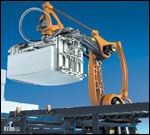
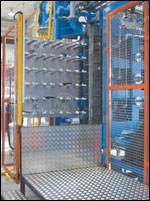
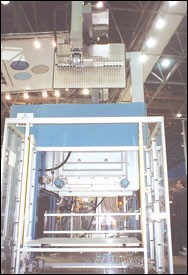
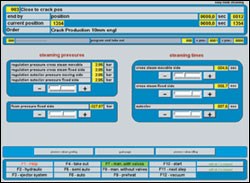
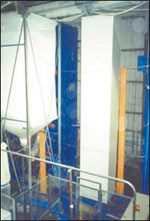












.png;maxWidth=300;quality=90)






